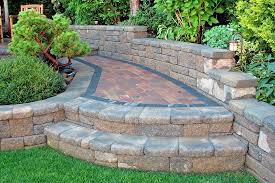Retaining walls play a crucial role in supporting soil and preventing erosion, making them an essential feature for many landscapes. However, like any structure, they require regular care and maintenance to ensure their longevity and structural integrity.
In this discussion, we will explore the various steps and tips to effectively care for a retaining wall, from cleaning and inspection to proper drainage and waterproofing.
Additionally, we will delve into the importance of vegetation control, landscape maintenance, and the necessary repairs to address cracks and damage.
By following these guidelines, you can ensure the longevity and stability of your retaining wall, safeguarding your property and enhancing its aesthetic appeal. Read How Retaining Walls Help Your Property.
Regular Cleaning and Inspection
Regular cleaning and inspection of a retaining wall is essential for maintaining its structural integrity and preventing any potential damage or deterioration. Retaining wall maintenance should include a thorough cleaning of the wall surface to remove any dirt, debris, or vegetation that may have accumulated. This can be done using a pressure washer or a stiff brush and mild detergent.
Regular inspection is crucial to identify any signs of wear and tear, such as cracks, bulges, or shifting. These issues, if left unaddressed, can lead to further damage and compromise the stability of the retaining wall. It is advisable to consult a professional for a comprehensive assessment and necessary repairs.
Additionally, regular inspection allows for prompt identification of drainage problems, which can contribute to erosion and undermine the integrity of the structure. By prioritizing regular cleaning and inspection, retaining wall care can be effectively managed, ensuring its longevity and functionality.
Proper Drainage and Waterproofing
To ensure the long-term stability and effectiveness of a retaining wall, proper drainage and waterproofing measures must be implemented. Without adequate drainage and waterproofing, water can accumulate behind the wall, causing hydrostatic pressure that can lead to structural damage and erosion.
Here are three essential steps to ensure proper drainage and waterproofing in retaining wall construction:
- Install a drainage system: A perforated pipe should be placed at the base of the wall to collect and redirect water away from the structure. This pipe should be surrounded by a layer of gravel to facilitate water flow.
- Use a waterproofing membrane: Apply a waterproofing membrane, such as a rubberized asphalt or a bituminous coating, to the back of the wall. This will prevent water from seeping through the wall and causing damage.
- Add weep holes: Weep holes are small openings placed at regular intervals along the base of the wall. These holes allow water to escape, reducing hydrostatic pressure and preventing water from accumulating behind the wall.
Vegetation Control and Landscape Maintenance
With proper drainage and waterproofing measures in place, the next crucial aspect to consider for the long-term care and maintenance of a retaining wall is vegetation control and landscape maintenance. Weed prevention and control are essential to ensure the stability and structural integrity of the wall. Weeds have strong, invasive root systems that can penetrate the wall’s surface, causing cracks and deterioration over time.
Regular inspection and removal of weeds, along with the application of herbicides, can effectively control weed growth. Additionally, mulching techniques can provide several benefits for retaining walls. Mulch helps retain moisture in the soil, reducing water runoff and erosion. It also acts as a barrier against weed germination and growth, further enhancing weed control efforts.
Proper mulching techniques, such as applying a thick layer of mulch around plants and avoiding direct contact with the wall, can greatly contribute to the longevity of the retaining wall.
Repairing Cracks and Damage
To ensure the structural integrity and longevity of a retaining wall, it is crucial to promptly address any cracks or damage that may arise. Ignoring these issues can lead to further deterioration and potentially costly repairs.
Here are three effective repair methods and prevention techniques for maintaining and fixing cracks and damage in a retaining wall:
- Epoxy Injection: This method involves injecting epoxy into the cracks to strengthen and seal them. It is suitable for hairline cracks and minor damage.
- Grouting: Grouting is used for larger cracks and voids. It involves filling the gaps with a cementitious material to restore the wall’s stability and prevent further damage.
- Reinforcement: For severe damage or structural issues, reinforcing the retaining wall may be necessary. This can involve adding steel bars or plates to provide additional support and strength.
To prevent cracks and damage from occurring in the first place, regular inspections and maintenance are essential. Proper drainage systems, ensuring proper backfill material, and avoiding excessive pressure on the wall are some prevention techniques to consider.
Professional Maintenance and Upkeep
Addressing cracks and damage in a retaining wall is crucial for its structural integrity and longevity; however, professional maintenance and upkeep are equally essential to ensure its continued stability and functionality. Professional maintenance involves regular inspections and proactive measures to prevent potential issues.
One important aspect of professional upkeep is professional sealing. This involves applying a specially formulated sealant that helps to protect the retaining wall from water damage, erosion, and the penetration of harmful substances. A professional sealing process ensures that the sealant is applied correctly, covering all vulnerable areas and providing an effective barrier against moisture and other potential threats.
Conclusion
Caring for a retaining wall is essential for its longevity and functionality. Regular cleaning and inspection, proper drainage and waterproofing, vegetation control, and repairing cracks and damage are crucial maintenance practices.
Additionally, seeking professional maintenance and upkeep can ensure the wall’s optimal condition. By following these steps, you can guarantee a retaining wall that stands strong and resilient against the test of time, like a fortress guarding its territory.

